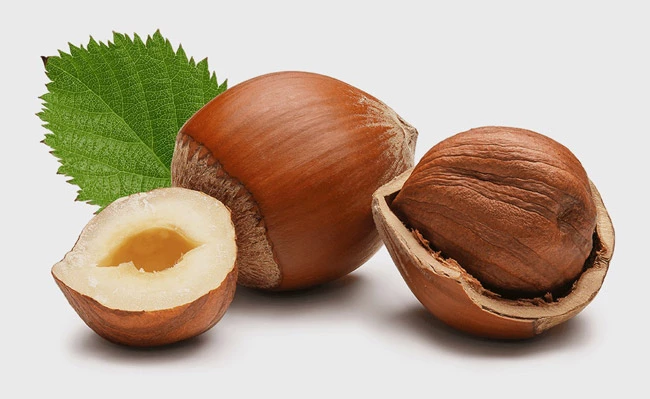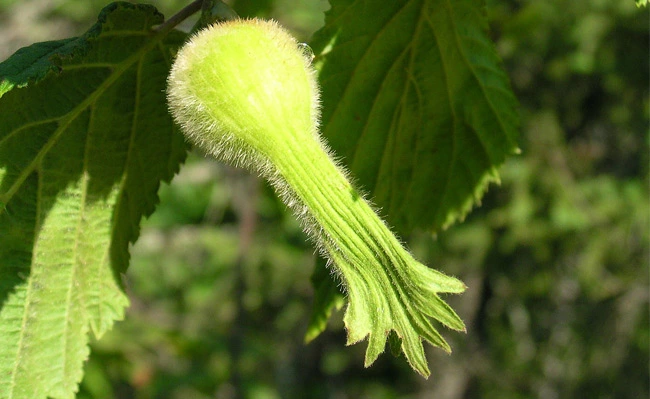Have you ever wondered what that earthy, nutty flavor base in Nutella is? Some of you may already know about the secret ingredient of Nutella: hazelnuts! Whether you call them hazelnuts or filberts, these exotic hazel-colored nuts’ unique taste and crunchy texture transform every food from ordinary to extraordinary.
In this article, we will be talking more about this wonderful, magical nut, its types, how to choose and store it, how to roast it, and how to deal with its allergic reactions in human beings.
What is a Hazelnut?
Hazelnut is the fruit nut of the hazel tree (Corylus). The fruit is round, pointed at one end, and surrounded by a hard shell. It usually is brown with stripes lined toward the pointed end. Some people call it filberts.

What Hazelnuts Taste Like
Hazelnuts are sweet with characteristic slight notes of musty and earthy. One of the significant flavor mixtures found in hazelnuts is fiber tone. Filbertone is a naturally occurring ketone found in hazelnut oil. It has a roasted, marbled, sweet, and long-lasting character.
Another important compound responsible for the smell of hazelnuts is the bean pyrazine. This compound has a fragrance described as pea-like, beany, earthy, chocolaty, and nutty. This is why bean pyrazine can also be found in coffee.
2-methoxy-3,5-dimethyl pyrazine is another compound found in hazelnuts that smells like almonds, roasted almonds, or the characteristic smell we know as hazelnuts.
Different Species of Hazelnuts
Hazelnuts are different in color and texture depending upon the type. The three main groups belong to different subspecies and are classified according to their shape, volume, and shell hardness:
- Corylus avellana racemosa Lam: These hazelnuts are grouped in clusters; they are round and huge and often netted. Examples of this group include: Santa María de Jesús, ‘San Juan”, ‘San Nicolás”, and ‘San Cono’.
- Corylus avellana glandules’ Lin: These hazelnuts have acorn shapes, variable sizes, with a cone shape of the narrower base and acuminate apex — not a very hard shell. Examples include: ‘Ghiannusa, ‘Cannellina, ‘Minnulara, ‘Panuttara, Bacilara, ‘Muddisi, ‘Piattiddara, common hazel, ordinary hazel, hazel of Spain, etc.
- Corylus avellana Maxima Lam: They have aspheric or round shapes, large or medium fruits, and hard shells. A few examples of this group include Napolitano hazel. ‘Badara ubertosa, ‘Cerro, ‘Pigra, ‘Privitera, ‘Balzanotto, ‘San Giorgio, ‘Reganati, ‘Rizo, ‘San Elmo, hazel of England, netted hazel, etc.
Different Varieties of Hazelnuts
Hybrid hazelnuts

The hybrid hazelnut combines the best characteristics of common species (European variety and beaked and American beaked, two native North American species) in one hazelnut. This is done by Hybrid Hazelnut Consortium.
Beaked Hazelnut

Key factors:
- Mature 4 to 7 cm.
- Branches that are glandless.
- Prickly hair on the involucres.
American Hazelnuts

Key factors:
- 5 to 3 cm mature.
- Young branches are mainly glandular.
European Hazelnuts

It is Corylus avellana, also known as European nuts.
Key factors:
- free-fall
- larger hazelnuts than American and Beaked hazelnuts
Nutrition and Health Benefits of Hazelnuts
One ounce (28 grams, or about 20 whole kernels) of hazelnuts contains the following nutrients and calories:
- Calories: 176
- Total fat: 17 grams
- Protein: 4.2 grams
- Carbs: 4.7 grams
- Fiber: 2.7 grams
- Vitamin E: 21% of the reference daily intake (RDI)
- Thiamin: 12% of the RDI
- Magnesium: 12% of the RDI
- Copper: 24% of the RDI
- Manganese: 87% of the RDI
(source: www.healthline.com)
This nutrient profile places hazelnuts among the healthiest food nuts. Common known health benefits of hazelnuts include:
Hazelnuts are loaded with antioxidants that protect the body against damage to cell structure and aging, cancer, and heart disease caused by oxidative stress.
- The antioxidant compounds in hazelnuts are also good for the heart.
- Hazelnuts help reduce cholesterol and LDL cholesterol levels in the body.
- The vitamins and minerals give hazelnuts some anti-cancer properties.
- The high concentrations of healthy fats in hazelnuts help reduce inflammatory markers.
How to Choose and Buy Perfect Hazelnuts
If you are buying hazelnuts in the shell, look for those that look full and feel heavy. Old nuts often dry in the shell, so they tend to be lighter.
If you are buying shelled nuts, search for the ones with tight skins and nuts that look plump. Shop at a store with a brisk turnover to get the freshest nuts possible.
There shouldn’t be any sign of mold growth anywhere on them. Mold growth is not very common and can only occur if the nuts are kept in a humid environment and are rotten.
Avoid discolored nuts or nuts with stains and blanches.
How to Store Hazelnuts
Fresh hazelnuts are perishable and delicate. Shelled hazelnuts should be consumed as soon as possible and kept at room temperature, away from heat and humidity. You can store them in the refrigerator or freezer for up to five months. Unshelled hazelnuts can be kept in a dry, cool place for a long time.
You can also store shelled hazelnuts in an airtight container or bag in the freezer, where they will stay fresh and tasty for one year or more. You can also store hazelnuts in an airtight container in a refrigerator between 32 and 35 degrees F, where they will keep fresh for up to eight months.
| Storage Method | Conditions | Recommended Duration | Notes |
|---|---|---|---|
| Room Temperature | Cool, dry place; airtight container | Up to 3 months | Suitable for shelled hazelnuts only if used quickly. |
| Refrigerator | Sealed container or zip-lock bag | 6 to 8 months | Helps retain freshness and prevent oil rancidity. |
| Freezer | Airtight freezer-safe container or vacuum-sealed bag | Up to 1 year or longer | Best method for long-term storage. Defrost before use. |
| In-Shell Storage | Cool, dry, dark place (with good ventilation) | Up to 1 year | Shell acts as a natural barrier. Avoid humidity. |
| Roasted Hazelnuts | Airtight container in fridge or freezer | 2–3 months (fridge) / 6+ months (freezer) | Roast just before use for best flavor. |
How to Peel and Roast Hazelnuts?
There are two ways to peel and roast hazelnuts.
- First method: By boiling and ice bathing the hazelnuts
- Second method: By roasting the nuts with the skin on and rubbing them in a clean towel
Follow these steps for each method to make excellent healthy snacks for yourself at home:
Boiling and Ice bathing Method
Things you will need for this method:
- 4 tablespoons of baking Soda
- A bowl of Ice water
- 4 cups of water
- 1 cup of hazelnuts
Step 1: Bring water to a boil in an average saucepan, add the baking soda to the boiling water, and instantly add the nuts. Be ready because the water will foam up right away. If it seems like it will bubble over, lower the heat immediately, and lift the pot off the heat. Don’t be like me and let the pan boil over.
Step 2: Boil for 3 or 4 minutes, stirring regularly.
To test if they are ready to blanch, lift one nut out with your slotted spoon and put it in the bowl of ice water. If the peels get off efficiently, you’re ready to go.
Step 3: Transfer the remaining nuts to the ice bath and peel off the skins. Put them on a baking cloth lined with paper towels as you go so they can dry.
Step 4: Preheat your oven to 350 and line a baking sheet with parchment paper. Place the nuts onto the baking sheet and cook for 10-12 minutes, shaking them around midway. Remember to keep a close eye on them to ensure they aren’t burning.
Roasting and Rubbing Method
Things you will need for the second method:
- 1 cup of hazelnuts
- A clean tea towel
Step 1: Preheat your oven to 400 and line a baking cloth with parchment paper. Spread out the hazelnuts and roast for 5 minutes. Remember to keep an eye on them to make sure they aren’t burning.
Step 2: Let them cool for 3 or 4 minutes, and then rub them in a clean tea towel to remove the peels.
What Do Chefs Say about Hazelnuts?
With their vibrant, sweet, and nutty flavor, hazelnuts can add a great crunchy texture to bakery products such as bread, muffins, brownies, cookies, cakes, and biscotti. They also add a great richness to salads, pastries, dressings, and sauces and are a tasty and nutritious addition to snack foods. Consider the following examples.
- Hazelnut and Dill: Dill has a sharp, green, lemony, and herbal flavor. Despite its vegetal combination, it has a great potential to combine with hazelnuts. Hazelnuts have a sophisticated earthy tone that can complement the herbal and green taste found in dill.
- Hazelnut and Avocado: Both of these ingredients are naturally marbled. Avocados have subtle notes of hazelnut and anise; this is why they can play off the authentic flavor of hazelnuts.
- Hazelnut and Garlic: Roasted Garlic has a caramelized sweet flavor heightened by the roasted nutty flavor of hazelnuts. Both are further magnified when lemon is added to add a dimension of sharpness and freshness. Try blending these ingredients for a sauce over chicken!
Hazelnut Allergy
Hazelnut allergy or allergic reaction to hazelnut is a result of the immune attacking the proteins in the nut. This triggers the production of immune chemicals, including histamine and antibodies, that cause the typical symptoms of allergic reactions. Avoid exposure to hazelnuts and other nuts that may trigger the allergy to prevent the allergic reaction.
Reactions to hazelnuts can also occur due to hidden hazelnut ingredients or traces of hazelnuts in a product. So, it would be best if you always looked at the product labeling before consuming any products to make sure they do not contain any hazelnut ingredients.
Hazelnut Allergy Symptoms
Hazelnut allergy is usually found in hay fever and tree pollen allergy patients. People suffering from an allergic reaction to hazelnut typically develop any of all of the following symptoms after the ingestion of hazelnuts:
- Itching
- Swelling
- Burning in the mouth and throat
The so-called “oral allergy syndrome” or food-pollen allergy is caused by cross-reactivity between tree pollen allergens, especially alder, birch, hazel pollen, and hazelnut proteins.
In addition to the “oral allergy syndrome,” rigorous allergic reactions to hazelnuts are reported in patients without any association with tree pollen allergy. These people usually display
- Hives (urticaria) or eczema on their skin
- Swelling of the lips and face (angioedema)
- Breezing difficulties (asthma or swelling of the throat)
- Vomiting, nausea
- Diarrhea, abdominal pain
- Wheezing, coughing, or a runny nose
- Anaphylactic shock – A serious allergic reaction that needs immediate medical care.
In case of allergic to hazelnuts, these symptoms may occur within two hours after consuming hazelnuts or food containing them.
Hazelnut Allergy Treatments
There is no actual cure for hazelnut allergy. You can manage your hazelnut allergy only by avoiding hazelnuts and preparing for future reactions.
Talk to your allergist or doctor if you have any unusual symptoms after eating or touching hazelnuts. You may require allergy testing to determine the severity of your reaction or determine if you have allergies to other nuts.
Conclusion
Hazelnuts are tiny on the look but huge on the inside. This article just scratched the surface about this magnificent fruit. Stay tuned for more in the future.
Have you tried hazelnuts before?
How did it taste? How did it feel?
Write about your experiences in the comment section.
FAQ

